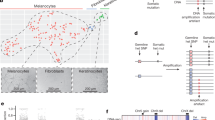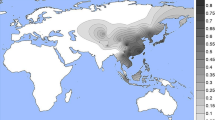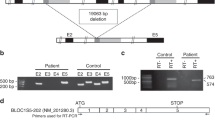Abstract
ON theoretical grounds, “racial” colour differences could be caused by a variety of factors (differences in the number of melanocytes, in melanin content, in melanosome morphology, in tyrosinase activity, and so on)1. It is known2–6 that colour differences in the guinea-pig and in man are not a consequence of any difference in the number of melanocytes. In these species, the inheritance of colour differences is more complicated than in the C57 mouse, where, for example, a single gene substitution at the D locus produces dramatic colour differences7. The C57Bl mouse (–DD–) is black, whereas the DBL mouse (–dd–) is dilute brown. It is not known, however, whether this gene substitution affects only the quality and quantity of pigment produced or is manifested by a reduction in the number of melanocytes. Furthermore, no thorough comparative study of the melanocyte system in the DBL strain, assessing melanocyte morphology in various body regions and thus determining possible effects of the tissue environment on the morphology of DBL melanocytes, has been carried out. Markert and Silvers reported8 that melanoblast differentiation in the “dilute” genotype is determined by factors intrinsic to melanoblasts, yet they later showed that, in certain cases (in transplants to the anterior chamber of the eye), the tissue environment also strongly influences the morphology of melanocytes9.
This is a preview of subscription content, access via your institution
Access options
Subscribe to this journal
Receive 51 print issues and online access
$199.00 per year
only $3.90 per issue
Buy this article
- Purchase on Springer Link
- Instant access to full article PDF
Prices may be subject to local taxes which are calculated during checkout
Similar content being viewed by others
References
Pathak, M. A., Sinesi, S. J., and Szabó, G., J. Invest. Dermatol., 45, 520 (1965).
Staricco, R. J., and Pinkus, H., J. Invest. Dermatol., 28, 33 (1957).
Mitchell, R. E., J. Invest. Dermatol., 41, 199 (1963).
Szabó, G., Phil. Trans. Roy. Soc., B, 252, 447 (1967).
Billingham, R. E., and Medawar, P. B., Phil. Trans. Roy. Soc., B, 237, 151 (1953).
Szabó, G., Adv. in Biol. Skin, The Pigmentary System, 8, 379 (edit. by Montagna, W.) (Pergamon Press, 1967).
Quevedo, jun., W. C., and Smith, J. A., Ann. NY Acad. Sci., 100, 364 (1963).
Markert, C. L., and Silvers, W. K., Genetics, 41, 429 (1956).
Markert, C. L., and Silvers, W. K., Pigment Cell Biology, 241 (Myron Gordon, Academic Press, 1959).
Author information
Authors and Affiliations
Rights and permissions
About this article
Cite this article
GERSON, D., SZABÓ, G. Effect of Single Gene Substitution on the Melanocyte System of the C57Bl Mouse : Quantitative and Qualitative Histology. Nature 218, 381–382 (1968). https://doi.org/10.1038/218381a0
Received:
Revised:
Issue Date:
DOI: https://doi.org/10.1038/218381a0
This article is cited by
-
Augenver�nderungen beim Merlesyndrom des Hundes
Albrecht von Graefes Archiv f�r Klinische und Experimentelle Ophthalmologie (1978)
-
Special Review Article
Journal of Investigative Dermatology (1969)
-
Specific Tolerance to Sheep Erythrocytes in Mouse Bone Marrow Cells
Nature (1969)
-
Immune Paralysis of Thymus Cells by Bovine Serum Albumin
Nature (1968)
Comments
By submitting a comment you agree to abide by our Terms and Community Guidelines. If you find something abusive or that does not comply with our terms or guidelines please flag it as inappropriate.



